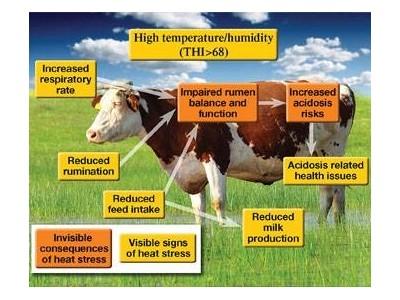Live yeast helps manage heat stress in dairy cows

Lallamand Animal Nutrition | This graphic illustrates the rumen-related consequences of heat stress and heat stress indicators visible at farm level.
Rumen modifiers, such as live yeast, can help alleviate the drawbacks of heat stress on digestive comfort and help preserve dairy performance
Heat stress impacts the health and performance of high-producing livestock; for example, heat stress costs the U.S. dairy industry more than $800 million a year. While practical herd management practices alleviate the effect of heat stress, it continues to represents challenges for the cow’s digestion -- and, it particularly impacts the cow’s rumen.
Even low or mild heat stress conditions can impact performance. Research shows that the heat stress threshold for dairy cows is in fact lower than previously thought, e.g. spending four hours/day above the temperature humidity index (THI) of 68 (this corresponds to 22 degrees Celsius for 50 percent relative humidity) can result in losses of more than 1 kg. milk/day.
Challenged rumen
A cow’s comfort zone is between 5 to 20 degrees Celsius. Under hot weather, they have two main ways of maintaining their thermal balance and regulating their body temperature:
Heat dispersion : Evaporation, increased sudation, panting, drooling -- these activities increase the maintenance energy needs of the animal. As a result, part of its milk production energy is redirected toward thermal regulation.
Limiting heat production through reduced activity and changed feeding patterns: Heat production in dairy cows is essentially due to rumen fermentations. Feed intake can be reduced by 10 to 30 percent. Also, rumination, which produces heat, decreases dramatically. Cows will tend to eat less during the day, but more often and in small quantities. They will tend to consume more feed at night when it is cooler, slug feed, sort feed and tend to choose feeds that produce less heat during digestion, i.e. grains and proteins over forages.
These factors and a new feeding pattern have a direct negative impact on dairy production – as well as rumen function and condition, which result in lower feed efficiency and higher acidosis risk with associated health risks, e.g. laminitis, inflammation and fertility.
Live yeast benefits in dairy cows
To help alleviate or limit the challenges of heat stress on the rumen, the use of rumen modifiers in cow diets is advocated by nutritionists. In particular, ruminant-specific live yeast is registered as a zootechnical additive, which optimizes rumen pH and enhances feed efficiency thanks to better fiber utilization.
Under standard, non-stressful conditions, a meta-analysis involving 14 trials and 1,600 dairy cows with various feeding conditions, showed Saccharomyces cerevisiae CNCM I-1077 significantly improves feed efficiency by an average 3 percent. A trial conducted under severe heat stress conditions (THI>80) indicated that this live yeast fed to dairy cows improved feed efficiency by up to 7 percent, equivalent to an extra 120g of milk/kg DMI. The same trial also indicated a positive effect on rumen pH, resulting in lower acidosis risk: 45 percent of cows had a pH lower than 5.8 percent in the control group.
Moderate heat stress tests
A new trial conducted on 40 Holstein dairy cows at the University of Bologna, Italy, evaluated the effect of this specific live yeast under lower heat stress conditions. More attention is being paid to digestive comfort because of its links to feed efficiency and animal welfare. Consequently, this trial not only looked at zootechnical performance (milk yield and milk solids), but also digestive criteria signs, such as rumen pH (monitored by a remote pH bolus); animal behavior (monitored by ruminating activity); and fiber digestion (evaluated through fecal analysis).
Here is an overview of its finding:
- Production benefits of the live yeast under moderate heat stress conditions: Milk yield and milk fat were improved, resulting in higher fat-corrected milk (+1.7 kg FCM/cow/day). The economic benefit for the farmer is estimated to be 21/cow/month.
- In the control group, heat stress condition is correlated with lower rumen pH. However, the study confirmed that the live yeast acts as rumen modifier and can improve rumen pH during heat stress.
- Optimal rumination, between 400 to 500 minutes/day, is sign of good rumen function; under 400 minutes/day could be a sign of bad rumen health and probably acidosis. (This criteria of digestive comfort was measured using RuminAct.) The number of cows achieving optimal rumination time is increased from 52 percent for control cows to 65 percent for animals fed the live yeast. This increased rumination will help better digestion and induce higher saliva production, which in turn can help control rumen pH (buffer).
Both rumen pH and rumination activity were improved with the live yeast. This better rumen function will impact directly fiber digestion (+4 percent of total tract NDF digestibility) and milk production (+1.7 kg of FCM).
Hence, under moderate heat stress, rumen-specific live yeast helps to stabilize rumen pH and digestive comfort, leading to better fiber degradation and milk production. This is translated into higher direct milk revenue for the producer and animal welfare benefits, i.e. increased comfort, reduced acidosis associated trouble like laminitis.
References available upon request.
Laurent Dussert is category manager with Lallemand Animal Nutrition.
Có thể bạn quan tâm
 Increasing cow feed profitability with sugar
Increasing cow feed profitability with sugar Research that has been done appears to indicate that using sugar in dairy cow feed has the potential to produce good quality meat and milk.
Heat stress is a natural phenomenon that affects dairy cows and other domestic animals in tropical, sub-tropical and often in temperate regions of the world
 Climate change increasing heat stress in dairy cows
Climate change increasing heat stress in dairy cows Dairy cows in traditionally cooler climates may have to cope with the effects of climate change – leaving producers combating the effects of heat stress.